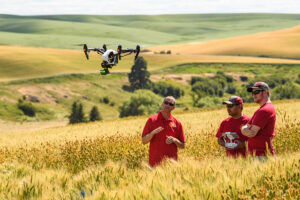By Arron Carter
Little did I know the changes that were going to take place in the next decade when I was hired in 2009 to run the winter wheat breeding and genetics program at Washington State University (WSU).
I have seen many private companies get into the wheat breeding business, along with a large increase in the number of varieties commercially available to growers. Advances in genetics have improved genotyping of breeding lines, opening the door to utilizing new tools to make selections. Increased availability of low cost and light-weight cameras and sensors have allowed plant breeders to look at traits not previously visible to the naked eye. All of these advances and more have altered how plant breeding is conducted, and in many cases, have made us more efficient in the selection process.

This summer will be my 12th field season at WSU, and I can assure you, I am not breeding and making selections like my predecessors, let alone when I first started. There are times I feel like I’m looking more toward the sky than I am looking down at the wheat. Why? The use of drones and sensors (known as phenomics) have become a new tool used in many plant breeding programs.
In some cases, data can be collected faster and with more accuracy using phenomics than I can alone, like when rating thousands of plots for percent of emergence from deep planting. Other times, sensors can give me information about plant health, water use efficiency and photosynthetic ability that cannot be seen by the eye. This additional trait information is allowing all breeders to select lines that are better adapted to the variable weather patterns found in the state.
Another tool currently used in breeding programs is known as genomic selection. When I started breeding, we could use one or two DNA markers to track a gene of interest. Now, we can use tens of thousands of markers to track thousands of genes that are beneficial to successful varieties. That means, instead of looking for genes one at a time, I can simultaneously select for many useful genes.
This technology is very beneficial for complex traits where many genes affect the outcome. Consider end-use quality. Typically, we use very expensive laboratory tests to evaluate the quality performance of wheat varieties. With genomic selection, I can use genetic information to make selections early in the breeding program while I am still evaluating thousands of lines. This allows me and my team to predict the best lines and advance them in the program. At later stages, when there are fewer lines, we can then use the laboratory tests to confirm the genetic predictions. This saves an untold amount of time, money and effort during the screening process.
While phenomics and genomic selection are two new methods used by many programs to make selections, some additional tools are on the horizon that may further alter how I breed wheat. One of these is gene-editing technology.
Gene editing is a very specific process in which researchers can alter the sequence of a gene, many times making a specific gene nonfunctional. For example, there is a gene call the PPO gene that causes products to turn brown when exposed to oxygen (like what happens when you cut open an apple). In wheat, it causes final products, especially noodles, to become discolored and undesirable. Altering the PPO gene, which has already been done in apples, can prevent this from occurring.
There are many other examples of how this technology might be used in wheat breeding. Researchers have considered altering genes to prevent fungal pathogen infection or to prevent toxins from being produced. Some researchers are investigating how to create wheat that can be eaten by people with celiac disease. For Eastern Washington farmers, perhaps the most interesting work being done is looking at altering the alpha-amylase enzyme pathway as a way to prevent low falling numbers.
None of this gene-editing technology is currently being used within the WSU breeding programs, but we are closely watching the research that is being conducted. Although the technology is different from GMO crops created through genetic engineering, gene editing will still require our customers’ approval before varieties can be commercialized.
Another technology that was tried decades ago, abandoned, and recently reinvigorated, is the development of hybrid wheat. In a typical wheat breeding program, two lines are crossed together to make an F1 plant. This plant is then self-pollinated for seven or more generations until all genes are in a stable (homozygous) form. This process allows the variety to “breed true” from year to year, permitting seed to be harvested and planted the next year, with no variation showing up in the field.
Hybrid wheat is basically the propagation of the F1 plant after making the cross. In many crops, these F1 hybrids bring along increased yield potential and more resilience to abiotic (environmental) stress. The downside is that these hybrids will segregate if grown a second year, so seed must be purchased annually. This requires significant investment in seed production as the plant must be cross-pollinated in large quantities under field conditions, something that is difficult to do in wheat, a traditionally self-pollinated crop.
Many private companies have invested in developing hybrid wheat. The big, still-unanswered question is will the gains in yield potential offset the difficulty in developing these hybrids every year for commercial production? Depending on this outcome, the next 10 years of wheat breeding may again see significant changes!
When I started this position in 2009, I never thought I would be using the tools and technology that I am today. Plant breeding has turned into so much more than walking fields and looking at breeding lines. I truly believe the incorporation of phenomics and genomics has improved our breeding efficiency and effectiveness.
With the support and in direct collaboration with the Washington Grain Commission, I’m excited by what we can accomplish with the new techniques already in our hands, not to mention the breeding tools that are sure to be discovered in the next 10 years!
This article originally appeared in the April 2021 issue of Wheat Life Magazine. Bold styling added for emphasis.

Arron Carter, Ph.D.
Arron Carter, Ph.D., holds the O.A. Vogel Endowed Chair of Wheat Breeding and Genetics at Washington State University. His research is directed toward breeding improved wheat varieties for cropping systems in Washington state that incorporate diverse rotations and environments. His research goal is to release high-yielding, disease resistant varieties with good end-use quality that will maintain profitability and reduce the risk to growers. New varieties are developed using a combination of traditional plant breeding methods, molecular marker technology, and biotechnology. Read more about Dr. Carter.
